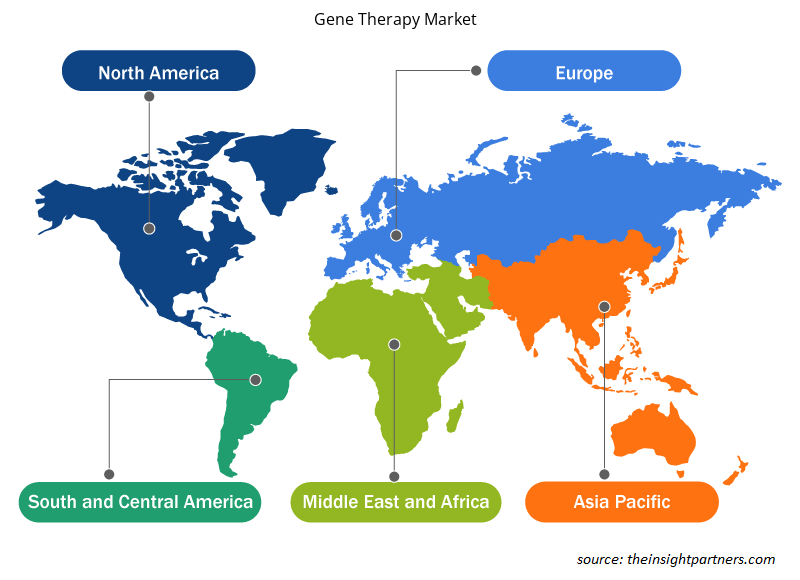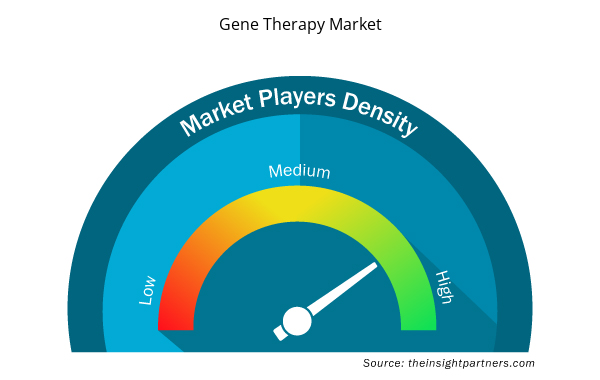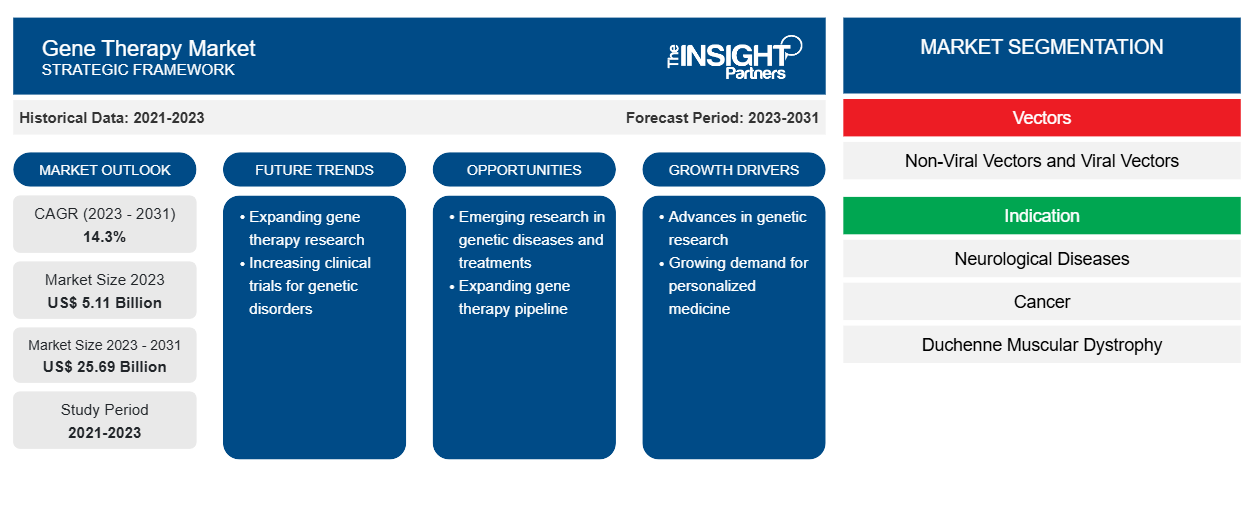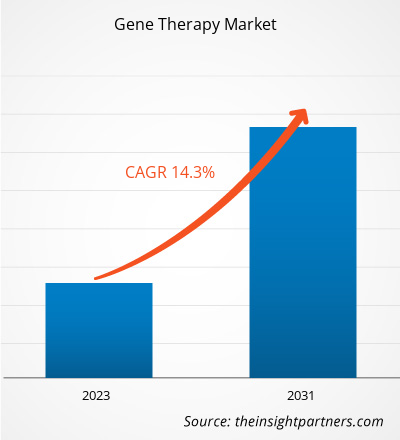[Rapport de recherche] Le marché de la thérapie génique devrait atteindre 25,69 milliards de dollars américains d'ici 2031, contre 5,11 milliards de dollars américains en 2023 ; le marché devrait enregistrer un TCAC de 14,3 % au cours de la période 2023-2031.
Informations sur le marché et point de vue des analystes :
La thérapie génique est un procédé de traitement des maladies par l'inactivation d'un gène responsable de la maladie, le remplacement d'un gène responsable de la maladie par une copie saine du gène ou l'introduction d'un gène nouveau ou modifié dans l'organisme pour aider à traiter et à prévenir la maladie. La thérapie génique peut être classée en thérapie génique in vivo et ex vivo. La thérapie génique vise à remplacer ou à corriger les gènes défectueux par des gènes normaux, permettant ainsi au corps de produire les protéines ou enzymes appropriées nécessaires à un fonctionnement normal, ce qui peut potentiellement guérir la cause sous-jacente des maladies. La prévalence croissante des maladies génétiques et du cancer dans le monde et le nombre croissant d'approbations de thérapies géniques par la FDA favorisent la croissance du marché de la thérapie génique . En outre, les tendances du marché de la thérapie génique incluent des avancées dans les technologies de thérapie génique qui favoriseront la croissance du marché à l'avenir.
Moteurs de croissance :
Les progrès de la biotechnologie ont conduit au développement de traitements pour un large éventail d'indications. Les thérapies géniques sont utilisées pour traiter diverses maladies, telles que le cancer, les troubles neurologiques et les troubles génétiques. À l'échelle mondiale, les thérapies géniques sont largement adoptées en raison de la disponibilité de produits approuvés par la Food and Drug Administration (FDA) des États-Unis. Voici quelques exemples de produits de thérapie génique approuvés par la FDA ces dernières années :
- En décembre 2023, la FDA a approuvé deux thérapies géniques cellulaires pour la drépanocytose. Lyfgenia (lovotibeglogene autotemcel) de Bluebird Bio a été autorisé pour les patients atteints de drépanocytose âgés de 12 ans et plus ayant des antécédents d'événements vaso-occlusifs. Il a été approuvé avec Casgevy (exagammglogene autotemcel), de Vertex Pharmaceuticals et CRISPR Therapeutics.
- En juin 2023, la FDA a approuvé Roctavian, une thérapie génique à base de vecteur viral adéno-associé pour le traitement des adultes atteints d'hémophilie A sévère sans anticorps préexistants contre le sérotype 5 du virus adéno-associé. L'hémophilie A héréditaire est un trouble hémorragique grave dû à une mutation génétique responsable de la production du facteur VIII (FVIII), une protéine qui permet la coagulation du sang. Roctavian est un produit de thérapie génique à usage unique qui contient un vecteur viral porteur d'un gène du facteur VIII de coagulation.
- En juin 2023, la FDA a approuvé Elevidys, la première thérapie génique pour le traitement de la dystrophie musculaire de Duchenne chez les patients pédiatriques âgés de 4 à 5 ans présentant une mutation confirmée du gène de la dystrophie musculaire de Duchenne et qui ne présentent pas de condition médicale préexistante empêchant le traitement avec cette thérapie.
- En novembre 2022, la FDA a approuvé HEMGENIX, fabriqué par CSL Behring LLC, une thérapie génique à base de virus adéno-associé recombinant de type 5 pour traiter les patients adultes atteints de certains types d'hémophilie B.
Par conséquent, l’approbation croissante de ces thérapies géniques alimente la croissance du marché de la thérapie génique.
Personnalisez ce rapport en fonction de vos besoins
Vous bénéficierez d'une personnalisation gratuite de n'importe quel rapport, y compris de certaines parties de ce rapport, d'une analyse au niveau des pays, d'un pack de données Excel, ainsi que de superbes offres et réductions pour les start-ups et les universités.
- Obtenez les principales tendances clés du marché de ce rapport.Cet échantillon GRATUIT comprendra une analyse de données, allant des tendances du marché aux estimations et prévisions.
Segmentation et portée du rapport :
L'analyse du marché de la thérapie génique a été réalisée en prenant en compte les segments suivants : vecteurs, indication, mode d'administration et géographie. Sur la base des vecteurs, le marché est classé en vecteurs non viraux et vecteurs viraux. En termes d'indication, le marché est classé en maladies neurologiques, cancer, dystrophie musculaire de Duchenne, maladies hépatologiques et autres indications. En termes de mode d'administration, le marché est divisé en in vivo et ex vivo. La portée du rapport sur le marché de la thérapie génique couvre l'Amérique du Nord (États-Unis, Canada et Mexique), l'Europe (France, Allemagne, Royaume-Uni, Espagne, Italie et reste de l'Europe), l'Asie-Pacifique (Chine, Japon, Inde, Australie, Corée du Sud et reste de l'Asie-Pacifique), le Moyen-Orient et l'Afrique (Arabie saoudite, Afrique du Sud, Émirats arabes unis et reste du Moyen-Orient et de l'Afrique) et l'Amérique du Sud et centrale (Brésil, Argentine et reste de l'Amérique du Sud et centrale).
Analyse segmentaire :
Le marché de la thérapie génique, par vecteurs, est classé en vecteurs non viraux et vecteurs viraux. Le segment des vecteurs viraux détenait une part de marché importante en 2023. Il est prévu qu'il enregistre un TCAC plus élevé sur le marché au cours de la période 2023-2030.
En fonction des indications, le marché est classé en maladies neurologiques, cancer, dystrophie musculaire de Duchenne, maladies hépatologiques et autres indications. Le segment du cancer détenait une part de marché importante de la thérapie génique en 2023 et devrait enregistrer le TCAC le plus élevé au cours de la période 2023-2030.
En fonction du mode d'administration, le marché est segmenté en in vivo et ex vivo. Le segment in vivo détenait une part de marché importante de la thérapie génique en 2023 et devrait enregistrer un TCAC plus élevé au cours de la période 2023-2030. La thérapie génique in vivo permet un traitement systématique, ce qui implique qu'elle peut atteindre plusieurs sites et organes dans tout le corps. Cela est particulièrement utile pour les maladies qui affectent plusieurs zones ou présentent des signes systématiques, ce qui permet une approche thérapeutique globale. En outre, le développement de technologies d'administration avancées, telles que les vecteurs viraux, les nanoparticules et les supports à base de lipides, a amélioré l'efficacité et la spécificité de la thérapie in vivo. Ces avancées stimulent l'administration ciblée de matériel génétique et améliorent la sécurité et l'efficacité de la thérapie.
Analyse régionale :
Géographiquement, le marché de la thérapie génique est segmenté en Amérique du Nord, Europe, Asie-Pacifique, Amérique du Sud et centrale, Moyen-Orient et Afrique. En 2023, l'Amérique du Nord a conquis une part importante du marché. En 2023, les États-Unis ont dominé le marché de la thérapie génique dans cette région. La croissance du marché en Amérique du Nord est attribuée à la prévalence croissante des troubles génétiques, au nombre croissant de patients atteints de cancer, à l'augmentation du financement gouvernemental, à l'adoption croissante de la thérapie génique avancée pour le traitement des maladies et à l'approbation croissante des produits.
Selon les Centres pour le contrôle et la prévention des maladies (CDC), environ 1 603 844 nouveaux cas de cancer ont été diagnostiqués en 2020, avec 602 347 décès par cancer aux États-Unis. Pour 100 000 personnes, 403 nouveaux cas de cancer ont été signalés. En outre, selon le Centre international de recherche sur le cancer, les nouveaux cas de cancer devraient atteindre 30,2 millions d'ici 2040. Selon les estimations du Government Accountability Office des États-Unis publiées en octobre 2021, environ 25 à 30 millions de personnes souffrent de maladies rares dans le pays ; près de 50 % des patients atteints de maladies rares sont des enfants. Les maladies rares sont souvent le résultat d'une mutation génétique ; on estime que 80 % des maladies rares sont génétiques.
Selon une mise à jour d'octobre 2021 des National Institutes of Health, 10 sociétés pharmaceutiques et 5 organisations à but non lucratif ont collaboré pour accélérer le développement de thérapies géniques pour les 30 millions d'Américains souffrant de maladies rares. La FDA américaine a approuvé 7 médicaments de thérapie cellulaire et génique, avec un pipeline de nouveaux produits atteignant environ 1 200 thérapies expérimentales. La moitié d'entre eux sont en phase 2 d'essais cliniques, avec des estimations de croissance annuelle des ventes représentant 15 % pour les thérapies cellulaires et environ 30 % pour les thérapies géniques, selon les estimations du rapport Chemical & Engineering News pour 2023. Tous ces facteurs mentionnés ci-dessus contribuent à la croissance de la taille du marché de la thérapie génique dans la région.
Aperçu régional du marché de la thérapie génique
Les tendances régionales et les facteurs influençant le marché de la thérapie génique tout au long de la période de prévision ont été expliqués en détail par les analystes d’Insight Partners. Cette section traite également des segments et de la géographie du marché de la thérapie génique en Amérique du Nord, en Europe, en Asie-Pacifique, au Moyen-Orient et en Afrique, ainsi qu’en Amérique du Sud et en Amérique centrale.

- Obtenez les données régionales spécifiques au marché de la thérapie génique
Portée du rapport sur le marché de la thérapie génique
| Attribut de rapport | Détails |
|---|---|
| Taille du marché en 2023 | 5,11 milliards de dollars américains |
| Taille du marché d'ici 2031 | 25,69 milliards de dollars américains |
| Taux de croissance annuel composé mondial (2023-2031) | 14,3% |
| Données historiques | 2021-2023 |
| Période de prévision | 2023-2031 |
| Segments couverts | Par vecteurs
|
| Régions et pays couverts | Amérique du Nord
|
| Leaders du marché et profils d'entreprises clés |
|
Densité des acteurs du marché de la thérapie génique : comprendre son impact sur la dynamique commerciale
Le marché de la thérapie génique connaît une croissance rapide, tirée par la demande croissante des utilisateurs finaux en raison de facteurs tels que l'évolution des préférences des consommateurs, les avancées technologiques et une plus grande sensibilisation aux avantages du produit. À mesure que la demande augmente, les entreprises élargissent leurs offres, innovent pour répondre aux besoins des consommateurs et capitalisent sur les tendances émergentes, ce qui alimente davantage la croissance du marché.
La densité des acteurs du marché fait référence à la répartition des entreprises ou des sociétés opérant sur un marché ou un secteur particulier. Elle indique le nombre de concurrents (acteurs du marché) présents sur un marché donné par rapport à sa taille ou à sa valeur marchande totale.
Les principales entreprises opérant sur le marché de la thérapie génique sont :
- Novartis SA
- Astellas Pharma Inc.
- Société Bristol-Myers Squibb
- Bluebird Bio Inc.
- Sanofi
Avis de non-responsabilité : les sociétés répertoriées ci-dessus ne sont pas classées dans un ordre particulier.

- Obtenez un aperçu des principaux acteurs du marché de la thérapie génique
Développements de l'industrie et opportunités futures :
Quelques initiatives prises par les acteurs du marché opérant dansLes marchés mondiaux de la thérapie génique sont répertoriés ci-dessous :
- En janvier 2022, Ori Biotech Ltd a obtenu plus de 100 millions de dollars américains lors d'un tour de financement de série B sursouscrit pour introduire sur le marché une plateforme innovante de fabrication de thérapie cellulaire et génique.
- En janvier 2020, Astellas Pharma Inc. a acquis Audentes Therapeutics, Inc. L'acquisition permet à la société combinée de devenir un leader mondial de la médecine génétique basée sur l'AAV.
Paysage concurrentiel et entreprises clés :
Les prévisions du marché de la thérapie génique peuvent aider les parties prenantes à planifier leurs stratégies de croissance. Novartis AG, Astellas Pharma Inc., Bristol-Myers Squibb Company, Bluebird Bio Inc., CSL Behring, Sanofi, F. Hoffmann-La Roche Ltd, Daiichi Sankyo, Biogen et Oxford Biomedica figurent parmi les principaux acteurs présentés dans le rapport sur le marché de la thérapie génique. Ces entreprises se concentrent sur l'introduction de nouveaux produits de haute technologie, les avancées des produits existants et les expansions géographiques pour répondre à la demande croissante des consommateurs dans le monde entier.
- Analyse historique (2 ans), année de base, prévision (7 ans) avec TCAC
- Analyse PEST et SWO
- Taille du marché Valeur / Volume - Mondial, Régional, Pays
- Industrie et paysage concurrentiel
- Ensemble de données Excel



Report Coverage
Revenue forecast, Company Analysis, Industry landscape, Growth factors, and Trends

Segment Covered
This text is related
to segments covered.

Regional Scope
North America, Europe, Asia Pacific, Middle East & Africa, South & Central America

Country Scope
This text is related
to country scope.
Questions fréquemment posées
The gene therapy market majorly consists of the players, including Novartis AG, Astellas Pharma Inc., Bristol-Myers Squibb Company, Bluebird Bio Inc., CSL Behring, Sanofi, F. Hoffmann-La Roche Ltd, Daiichi Sankyo, Biogen, and Oxford Biomedica.
The gene therapy market was valued at US$ 5.11 billion in 2023.
The factors driving the growth of the gene therapy market include the increasing burden of genetic diseases and the rising number of FDA approvals of gene therapies. However, the high cost of gene therapy products hampers the growth of the gene therapy market.
The gene therapy market is expected to be valued at US$ 25.69 billion in 2031.
The global gene therapy market is segmented based on vectors, indication, and delivery mode. Based on indication, the gene therapy market is categorized into neurological diseases, cancer, Duchenne muscular dystrophy, hepatological diseases, and other indications. The cancer segment held a significant market share in 2023 and is anticipated to record the highest CAGR in the market during 2023–2031.
Gene therapy is a process for the treatment of diseases by inactivating a disease-causing gene, replacing a disease-causing gene with a healthy copy of the gene, or introducing a new or modified gene into the body to help treat and prevent the disease.
Trends and growth analysis reports related to Life Sciences : READ MORE..
The List of Companies - Gene Therapy Market
- Novartis AG
- Astellas Pharma Inc.
- Bristol-Myers Squibb Company
- Bluebird Bio Inc.
- Sanofi
- F. Hoffmann-La Roche Ltd
- Daiichi Sankyo
- CSL Behring
- Biogen
- Oxford Biomedica.
The Insight Partners performs research in 4 major stages: Data Collection & Secondary Research, Primary Research, Data Analysis and Data Triangulation & Final Review.
- Data Collection and Secondary Research:
As a market research and consulting firm operating from a decade, we have published and advised several client across the globe. First step for any study will start with an assessment of currently available data and insights from existing reports. Further, historical and current market information is collected from Investor Presentations, Annual Reports, SEC Filings, etc., and other information related to company’s performance and market positioning are gathered from Paid Databases (Factiva, Hoovers, and Reuters) and various other publications available in public domain.
Several associations trade associates, technical forums, institutes, societies and organization are accessed to gain technical as well as market related insights through their publications such as research papers, blogs and press releases related to the studies are referred to get cues about the market. Further, white papers, journals, magazines, and other news articles published in last 3 years are scrutinized and analyzed to understand the current market trends.
- Primary Research:
The primarily interview analysis comprise of data obtained from industry participants interview and answers to survey questions gathered by in-house primary team.
For primary research, interviews are conducted with industry experts/CEOs/Marketing Managers/VPs/Subject Matter Experts from both demand and supply side to get a 360-degree view of the market. The primary team conducts several interviews based on the complexity of the markets to understand the various market trends and dynamics which makes research more credible and precise.
A typical research interview fulfils the following functions:
- Provides first-hand information on the market size, market trends, growth trends, competitive landscape, and outlook
- Validates and strengthens in-house secondary research findings
- Develops the analysis team’s expertise and market understanding
Primary research involves email interactions and telephone interviews for each market, category, segment, and sub-segment across geographies. The participants who typically take part in such a process include, but are not limited to:
- Industry participants: VPs, business development managers, market intelligence managers and national sales managers
- Outside experts: Valuation experts, research analysts and key opinion leaders specializing in the electronics and semiconductor industry.
Below is the breakup of our primary respondents by company, designation, and region:

Once we receive the confirmation from primary research sources or primary respondents, we finalize the base year market estimation and forecast the data as per the macroeconomic and microeconomic factors assessed during data collection.
- Data Analysis:
Once data is validated through both secondary as well as primary respondents, we finalize the market estimations by hypothesis formulation and factor analysis at regional and country level.
- Macro-Economic Factor Analysis:
We analyse macroeconomic indicators such the gross domestic product (GDP), increase in the demand for goods and services across industries, technological advancement, regional economic growth, governmental policies, the influence of COVID-19, PEST analysis, and other aspects. This analysis aids in setting benchmarks for various nations/regions and approximating market splits. Additionally, the general trend of the aforementioned components aid in determining the market's development possibilities.
- Country Level Data:
Various factors that are especially aligned to the country are taken into account to determine the market size for a certain area and country, including the presence of vendors, such as headquarters and offices, the country's GDP, demand patterns, and industry growth. To comprehend the market dynamics for the nation, a number of growth variables, inhibitors, application areas, and current market trends are researched. The aforementioned elements aid in determining the country's overall market's growth potential.
- Company Profile:
The “Table of Contents” is formulated by listing and analyzing more than 25 - 30 companies operating in the market ecosystem across geographies. However, we profile only 10 companies as a standard practice in our syndicate reports. These 10 companies comprise leading, emerging, and regional players. Nonetheless, our analysis is not restricted to the 10 listed companies, we also analyze other companies present in the market to develop a holistic view and understand the prevailing trends. The “Company Profiles” section in the report covers key facts, business description, products & services, financial information, SWOT analysis, and key developments. The financial information presented is extracted from the annual reports and official documents of the publicly listed companies. Upon collecting the information for the sections of respective companies, we verify them via various primary sources and then compile the data in respective company profiles. The company level information helps us in deriving the base number as well as in forecasting the market size.
- Developing Base Number:
Aggregation of sales statistics (2020-2022) and macro-economic factor, and other secondary and primary research insights are utilized to arrive at base number and related market shares for 2022. The data gaps are identified in this step and relevant market data is analyzed, collected from paid primary interviews or databases. On finalizing the base year market size, forecasts are developed on the basis of macro-economic, industry and market growth factors and company level analysis.
- Data Triangulation and Final Review:
The market findings and base year market size calculations are validated from supply as well as demand side. Demand side validations are based on macro-economic factor analysis and benchmarks for respective regions and countries. In case of supply side validations, revenues of major companies are estimated (in case not available) based on industry benchmark, approximate number of employees, product portfolio, and primary interviews revenues are gathered. Further revenue from target product/service segment is assessed to avoid overshooting of market statistics. In case of heavy deviations between supply and demand side values, all thes steps are repeated to achieve synchronization.
We follow an iterative model, wherein we share our research findings with Subject Matter Experts (SME’s) and Key Opinion Leaders (KOLs) until consensus view of the market is not formulated – this model negates any drastic deviation in the opinions of experts. Only validated and universally acceptable research findings are quoted in our reports.
We have important check points that we use to validate our research findings – which we call – data triangulation, where we validate the information, we generate from secondary sources with primary interviews and then we re-validate with our internal data bases and Subject matter experts. This comprehensive model enables us to deliver high quality, reliable data in shortest possible time.


 Obtenez un échantillon gratuit pour ce rapport
Obtenez un échantillon gratuit pour ce rapport